Tachism: Tri-Port Antenna with Triple Notching Characteristic and High Isolation System for MIMO Application
Abstract
:1. Introduction
1.1. Contribution of the Research
- 1.
- A third notch for the X-band was successfully created with the help of mutual coupling between already placed notching elements for WiMax and WLAN. To the best of the authors’ knowledge, the element’s structure is based on the novel shape of the Ottoman Empire’s KAYI-shape flag with a common KITE ground plane.
- 2.
- The UWB-MIMO antenna has a size of 30 × 30 × 1.6 mm. The radiating elements are placed with a symmetrical phase of from each other. This tri port symmetry is beneficial in many ways and help to avoid various constraints of the PCB design, whereby the antenna and other electronic components are placed in a small space and compact geometry.
- 3.
- The space on PCB is sometimes not inline to creating 1 × 4 or 2 × 2 MIMO configurations. Therefore, there is a need for a circular configuration to have three MIMO antennas with a symmetric phase of . The symmetric phase difference between the antenna elements produced at least lower mutual coupling in the MIMO system as compared to a MIMO configuration on the same scale.
- 4.
- The parasitic strip are loaded with slits having inverted an L-shaped and inverted U-shaped slots, which are used for the notching characteristics of WiMax and WLAN bands, respectively.
- 5.
- The simulated and fabricated KAYI-KITE-shaped UWB-MIMO antenna have a small size, good impedance matching, high mutual coupling between the antenna elements, good diversity performance, and triple-notched band characteristics using only two notching elements. The mutual coupling between the notching elements of the antenna are used to take advantage of creating the third notch band.
1.2. Organization of the Article
2. Antenna Designing and Operation Mechanism
2.1. Design of UWB Antenna
2.2. Design of Band Notch Elements
2.2.1. WiMax Band Notch Element Design
2.2.2. WLAN Band Notch Element Design
2.2.3. Satellite Band Notch Using Mutual Coupling
3. Results and Discussion
3.1. S-Parameters Analysis
3.2. Radiation Patterns
3.3. Peak Gain
3.4. Transmission Coefficient
3.5. MIMO Decoupling Structure
4. Diversity Performance
4.1. Envelope Correlation Coefficient (ECC)
4.2. Diversity Gain (DG)
4.3. Mean Effective Gain (MEG)
4.4. Total Active Reflection Coefficient (TARC)
4.5. Channel Capacity Loss (CCL)
4.6. Comparison Table with Existing Models
5. Conclusions
Author Contributions
Funding
Data Availability Statement
Conflicts of Interest
References
- Aiello, G.R.; Rogerson, G.D. Ultra-wideband wireless systems. IEEE Microw. Mag. 2003, 4, 36–47. [Google Scholar] [CrossRef]
- Kaiser, T.; Zheng, F.; Dimitrov, E. An overview of ultra-wide-band systems with MIMO. Proc. IEEE 2009, 97, 285–312. [Google Scholar] [CrossRef]
- Staderini, E.M. UWB radars in medicine. IEEE Aerosp. Electron. Syst. Mag. 2002, 17, 13–18. [Google Scholar] [CrossRef]
- Zhang, J.; Orlik, P.V.; Sahinoglu, Z.; Molisch, A.F.; Kinney, P. UWB systems for wireless sensor networks. Proc. IEEE 2009, 97, 313–331. [Google Scholar] [CrossRef]
- Sobhani, B.; Paolini, E.; Giorgetti, A.; Mazzotti, M.; Chiani, M. Target tracking for UWB multistatic radar sensor networks. IEEE J. Sel. Top. Signal Process. 2013, 8, 125–136. [Google Scholar] [CrossRef]
- Tang, Z.; Wu, X.; Zhan, J.; Hu, S.; Xi, Z.; Liu, Y. Compact UWB-MIMO antenna with high isolation and triple band-notched characteristics. IEEE Access 2019, 7, 19856–19865. [Google Scholar] [CrossRef]
- Abd El-Hameed, A.; Wahab, M.; Elboushi, A.; Elpeltagy, M.S. Miniaturized triple band-notched quasi-self complementary fractal antenna with improved characteristics for UWB applications. AEU-Int. J. Electron. Commun. 2019, 108, 163–171. [Google Scholar] [CrossRef]
- Hosseini, H.; Hassani, H.; Amini, M. Miniaturised multiple notched omnidirectional UWB monopole antenna. Electron. Lett. 2018, 54, 472–474. [Google Scholar] [CrossRef]
- Li, J.; Zhang, X.; Chen, J.; Chen, J.; Da Xu, K.; Zhang, A. Circularly polarized co-designed filtering annular slot antenna. AEU-Int. J. Electron. Commun. 2018, 90, 30–35. [Google Scholar] [CrossRef]
- Ranjan, P.; Raj, S.; Upadhyay, G.; Tripathi, S.; Tripathi, V.S. Circularly slotted flower shaped UWB filtering antenna with high peak gain performance. AEU-Int. J. Electron. Commun. 2017, 81, 209–217. [Google Scholar] [CrossRef]
- Iqbal, A.; Saraereh, O.A.; Ahmad, A.W.; Bashir, S. Mutual coupling reduction using F-shaped stubs in UWB-MIMO antenna. IEEE Access 2017, 6, 2755–2759. [Google Scholar] [CrossRef]
- Chandel, R.; Gautam, A.K.; Rambabu, K. Tapered fed compact UWB MIMO-diversity antenna with dual band-notched characteristics. IEEE Trans. Antennas Propag. 2018, 66, 1677–1684. [Google Scholar] [CrossRef]
- Dkiouak, A.; Zakriti, A.; El Ouahabi, M. Design of a compact dual-band MIMO antenna with high isolation for WLAN and X-band satellite by using orthogonal polarization. J. Electromagn. Waves Appl. 2020, 34, 1254–1267. [Google Scholar] [CrossRef]
- Prabhu, P.; Malarvizhi, S. Novel double-side EBG based mutual coupling reduction for compact quad port UWB MIMO antenna. AEU-Int. J. Electron. Commun. 2019, 109, 146–156. [Google Scholar] [CrossRef]
- Kumar, N.; Kiran, K.U. Meander-line electromagnetic bandgap structure for UWB MIMO antenna mutual coupling reduction in E-plane. AEU-Int. J. Electron. Commun. 2020, 127, 153423. [Google Scholar] [CrossRef]
- Li, J.F.; Chu, Q.X.; Huang, T.G. A compact wideband MIMO antenna with two novel bent slits. IEEE Trans. Antennas Propag. 2011, 60, 482–489. [Google Scholar] [CrossRef]
- Luo, C.M.; Hong, J.S.; Zhong, L.L. Isolation enhancement of a very compact UWB-MIMO slot antenna with two defected ground structures. IEEE Antennas Wirel. Propag. Lett. 2015, 14, 1766–1769. [Google Scholar] [CrossRef]
- Satam, V.; Nema, S. Two element compact UWB diversity antenna with combination of DGS and parasitic elements. Wirel. Pers. Commun. 2018, 98, 2901–2911. [Google Scholar] [CrossRef]
- Khan, M.S.; Capobianco, A.D.; Asif, S.M.; Anagnostou, D.E.; Shubair, R.M.; Braaten, B.D. A compact CSRR-enabled UWB diversity antenna. IEEE Antennas Wirel. Propag. Lett. 2016, 16, 808–812. [Google Scholar] [CrossRef]
- Hassan, M.M.; Rasool, M.; Asghar, M.U.; Zahid, Z.; Khan, A.A.; Rashid, I.; Rauf, A.; Bhatti, F.A. A novel UWB MIMO antenna array with band notch characteristics using parasitic decoupler. J. Electromagn. Waves Appl. 2020, 34, 1225–1238. [Google Scholar] [CrossRef]
- Yuan, X.T.; He, W.; Hong, K.D.; Han, C.Z.; Chen, Z.; Yuan, T. Ultra-wideband MIMO antenna system with high element-isolation for 5G smartphone application. IEEE Access 2020, 8, 56281–56289. [Google Scholar] [CrossRef]
- Lin, G.S.; Sung, C.H.; Chen, J.L.; Chen, L.S.; Houng, M.P. Isolation improvement in UWB MIMO antenna system using carbon black film. IEEE Antennas Wirel. Propag. Lett. 2016, 16, 222–225. [Google Scholar] [CrossRef]
- Elsharkawy, R.R.; Abd El-Hameed, A.S.; El-Nady, S. Quad-port MIMO Filtenna with High Isolation Employing BPF with High out of Band Rejection. IEEE Access 2021, 10, 3814–3824. [Google Scholar] [CrossRef]
- Abd El-Hameed, A.S.; Wahab, M.G.; Elshafey, N.A.; Elpeltagy, M.S. Quad-Port UWB MIMO antenna based on LPF with vast rejection band. AEU-Int. J. Electron. Commun. 2021, 134, 153712. [Google Scholar] [CrossRef]
- Jehangir, S.S.; Sharawi, M.S. A miniaturized UWB biplanar Yagi-like MIMO antenna system. IEEE Antennas Wirel. Propag. Lett. 2017, 16, 2320–2323. [Google Scholar] [CrossRef]
- Sipal, D.; Abegaonkar, M.P.; Koul, S.K. Easily extendable compact planar UWB MIMO antenna array. IEEE Antennas Wirel. Propag. Lett. 2017, 16, 2328–2331. [Google Scholar] [CrossRef]
- Chen, Z.; Zhou, W.; Hong, J. A miniaturized MIMO antenna with triple band-notched characteristics for UWB applications. IEEE Access 2021, 9, 63646–63655. [Google Scholar] [CrossRef]
- Elfergani, I.; Rodriguez, J.; Iqbal, A.; Sajedin, M.; Zebiri, C.; AbdAlhameed, R.A. Compact Millimeter-Wave MIMO Antenna for 5G Applications. In Proceedings of the 2020 14th European Conference on Antennas and Propagation (EuCAP), Copenhagen, Denmark, 15–20 March 2020; pp. 1–5. [Google Scholar]
- Altaf, A.; Iqbal, A.; Smida, A.; Smida, J.; Althuwayb, A.A.; Hassan Kiani, S.; Alibakhshikenari, M.; Falcone, F.; Limiti, E. Isolation Improvement in UWB-MIMO Antenna System Using Slotted Stub. Electronics 2020, 9, 1582. [Google Scholar] [CrossRef]
- Serghiou, D.; Khalily, M.; Singh, V.; Araghi, A.; Tafazolli, R. Sub-6 GHz Dual-Band 8 × 8 MIMO Antenna for 5G Smartphones. IEEE Antennas Wirel. Propag. Lett. 2020, 19, 1546–1550. [Google Scholar] [CrossRef]
- Ren, Z.; Zhao, A. Dual-Band MIMO Antenna With Compact Self-Decoupled Antenna Pairs for 5G Mobile Applications. IEEE Access 2019, 7, 82288–82296. [Google Scholar] [CrossRef]



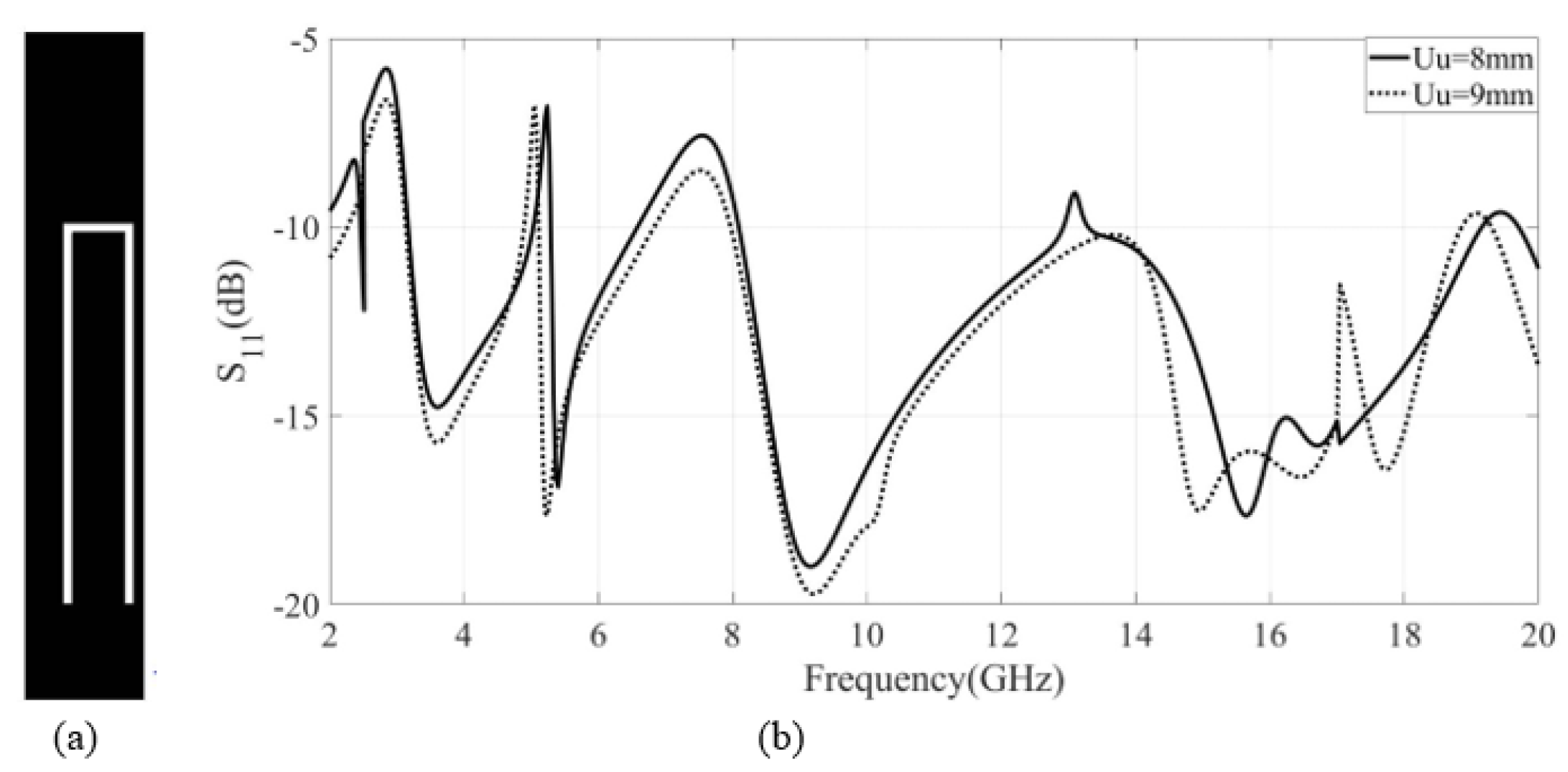

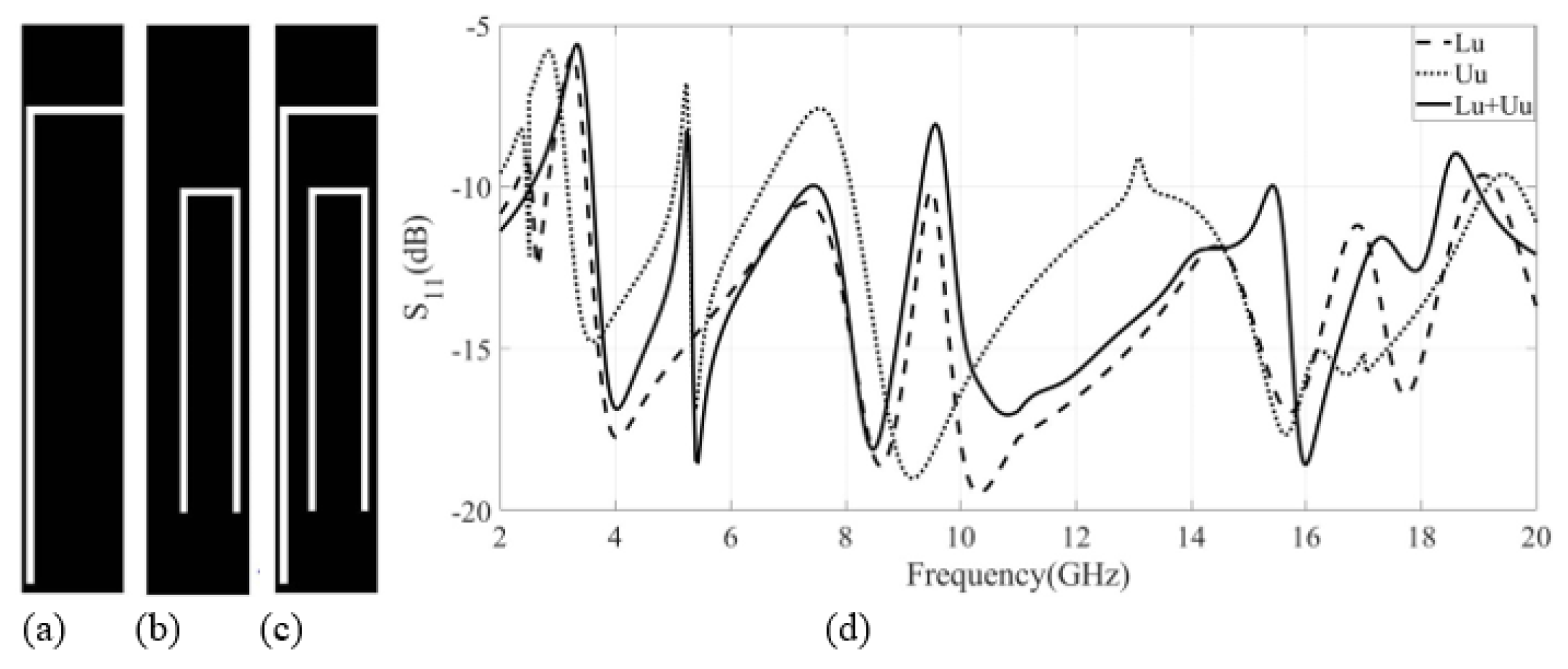

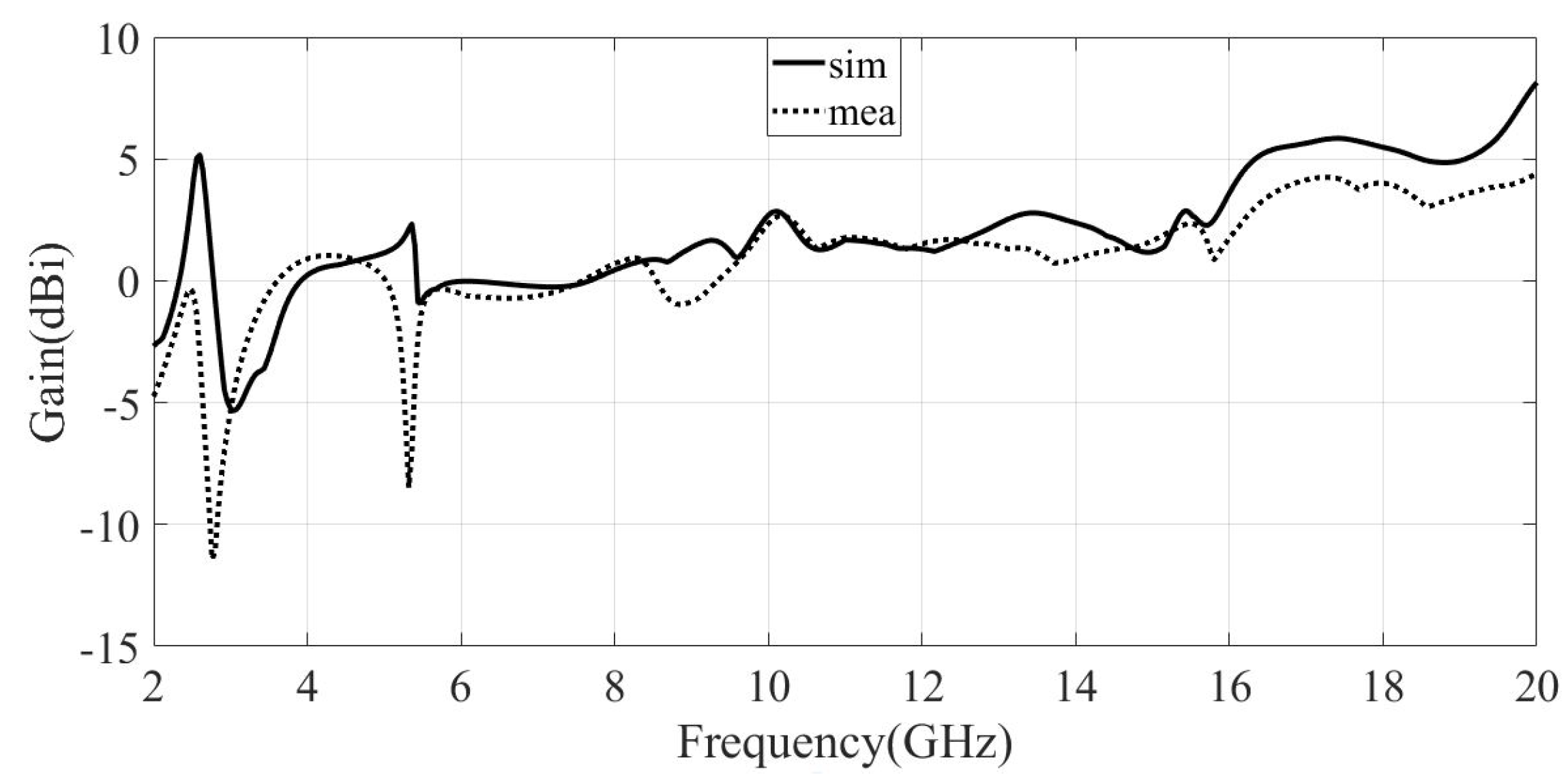

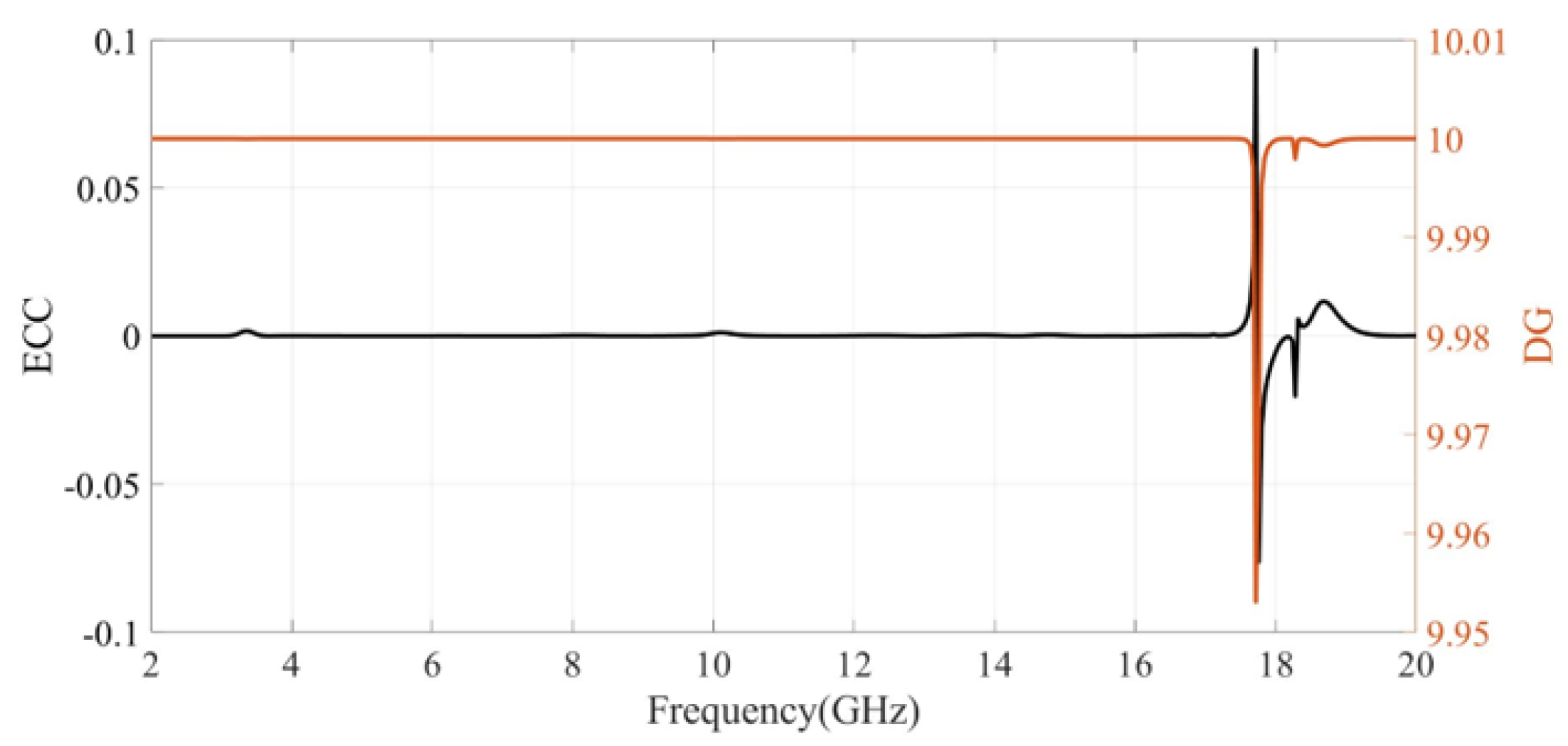


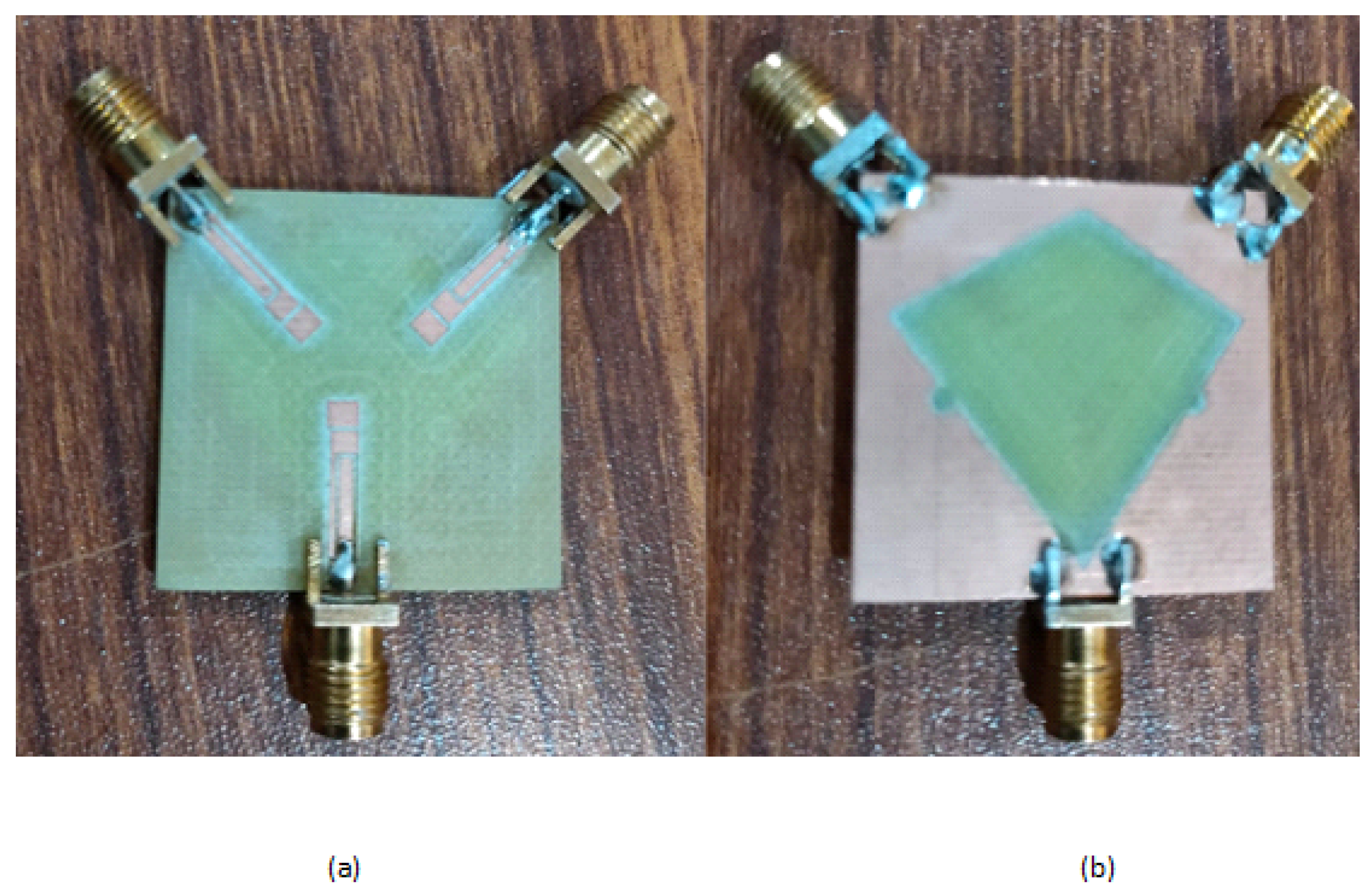
| Parameter | Values (mm) | Parameter | Values (mm) |
|---|---|---|---|
| L | 30 | W | 30 |
| 14 | 2.5 | ||
| 8.5 | 2.5 | ||
| 4 | 1 | ||
| 4 | 15 | ||
| 22 | C | 1 |
| Ref | A1 | A2 | A3 | A4 | A5 | A6 | A7 | A8 | A9 |
|---|---|---|---|---|---|---|---|---|---|
| [8] | 39 × 39 | 2.3–13.75 | 4.6 | 3 | L & U | >22 | <0.02 | 9.5 | 0.2 |
| [11] | 50 × 30 | 2.5–14.5 | 4 | - | - | >20 | 0.04 | >7.4 | - |
| [12] | 34 × 18 | 2.93–20 | 7 | 2 | L | >22 | 0.01 | >9.95 | - |
| [13] | 27 × 21 | 5.12–5.31 | 7.41–7.71 | >9.38 | 0 | - | 21 | 0.04 | 9.78 |
| [20] | 67 × 67 | 3.5–4.4 | 5.6–20 | 8.1 | 1 | U | 20 | <0.01 | 9.9 |
| [23] | 50 × 50 | 2.4–18 | 5 | 3 | C | 30 | 0.00021 | 9.9 | <0.2 |
| [24] | 43 × 43 | 2.15–20 | 5 | - | - | -20 | 0.1 | 9.9 | <0.4 |
| [25] | 80 × 50 | 4.18–6.58 | 4 | - | - | >17 | 0.056 | 9.98 | - |
| [26] | 38 × 38 | 3.0–15.0 | 0.5–5.0 | - | - | >15 | <0.15 | 9.8 | <0.4 |
| [27] | 34 × 34 | 2.5–12 | 2.5–5.5 | 3 | C, L & EBG | >15 | <0.05 | 9.98 | |
| A10 | 30 × 30 | 2.5–20 | 5.5 | 3 | L & U | >22 | 0.01 | 10 | <0.1 |
Publisher’s Note: MDPI stays neutral with regard to jurisdictional claims in published maps and institutional affiliations. |
© 2022 by the authors. Licensee MDPI, Basel, Switzerland. This article is an open access article distributed under the terms and conditions of the Creative Commons Attribution (CC BY) license (https://creativecommons.org/licenses/by/4.0/).
Share and Cite
Basir, S.; Khurshaid, T.; Alimgeer, K.S.; Akbar, M.; Nauman, A. Tachism: Tri-Port Antenna with Triple Notching Characteristic and High Isolation System for MIMO Application. Mathematics 2022, 10, 4491. https://doi.org/10.3390/math10234491
Basir S, Khurshaid T, Alimgeer KS, Akbar M, Nauman A. Tachism: Tri-Port Antenna with Triple Notching Characteristic and High Isolation System for MIMO Application. Mathematics. 2022; 10(23):4491. https://doi.org/10.3390/math10234491
Chicago/Turabian StyleBasir, Shahid, Tahir Khurshaid, Khurram Saleem Alimgeer, Madiha Akbar, and Ali Nauman. 2022. "Tachism: Tri-Port Antenna with Triple Notching Characteristic and High Isolation System for MIMO Application" Mathematics 10, no. 23: 4491. https://doi.org/10.3390/math10234491
APA StyleBasir, S., Khurshaid, T., Alimgeer, K. S., Akbar, M., & Nauman, A. (2022). Tachism: Tri-Port Antenna with Triple Notching Characteristic and High Isolation System for MIMO Application. Mathematics, 10(23), 4491. https://doi.org/10.3390/math10234491







